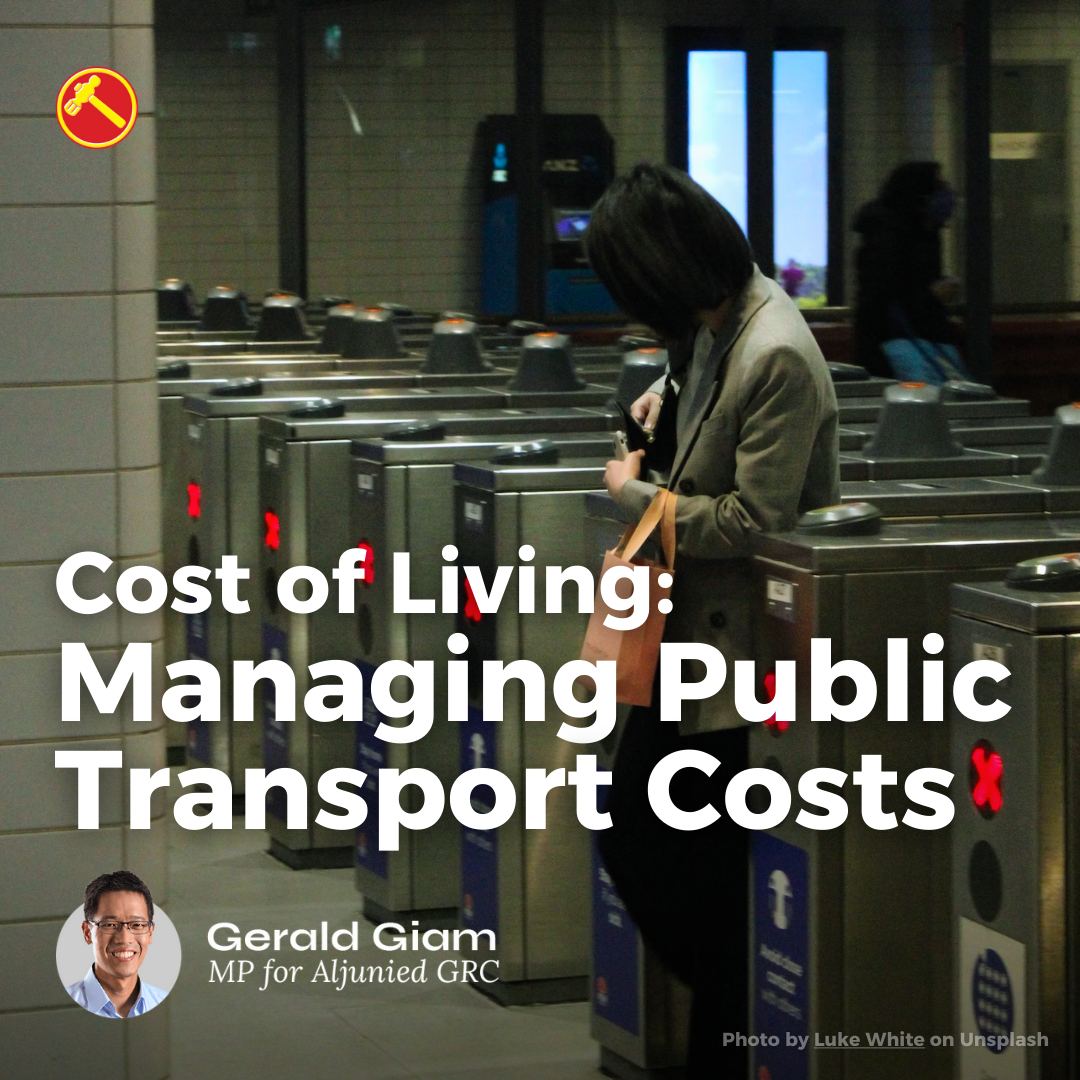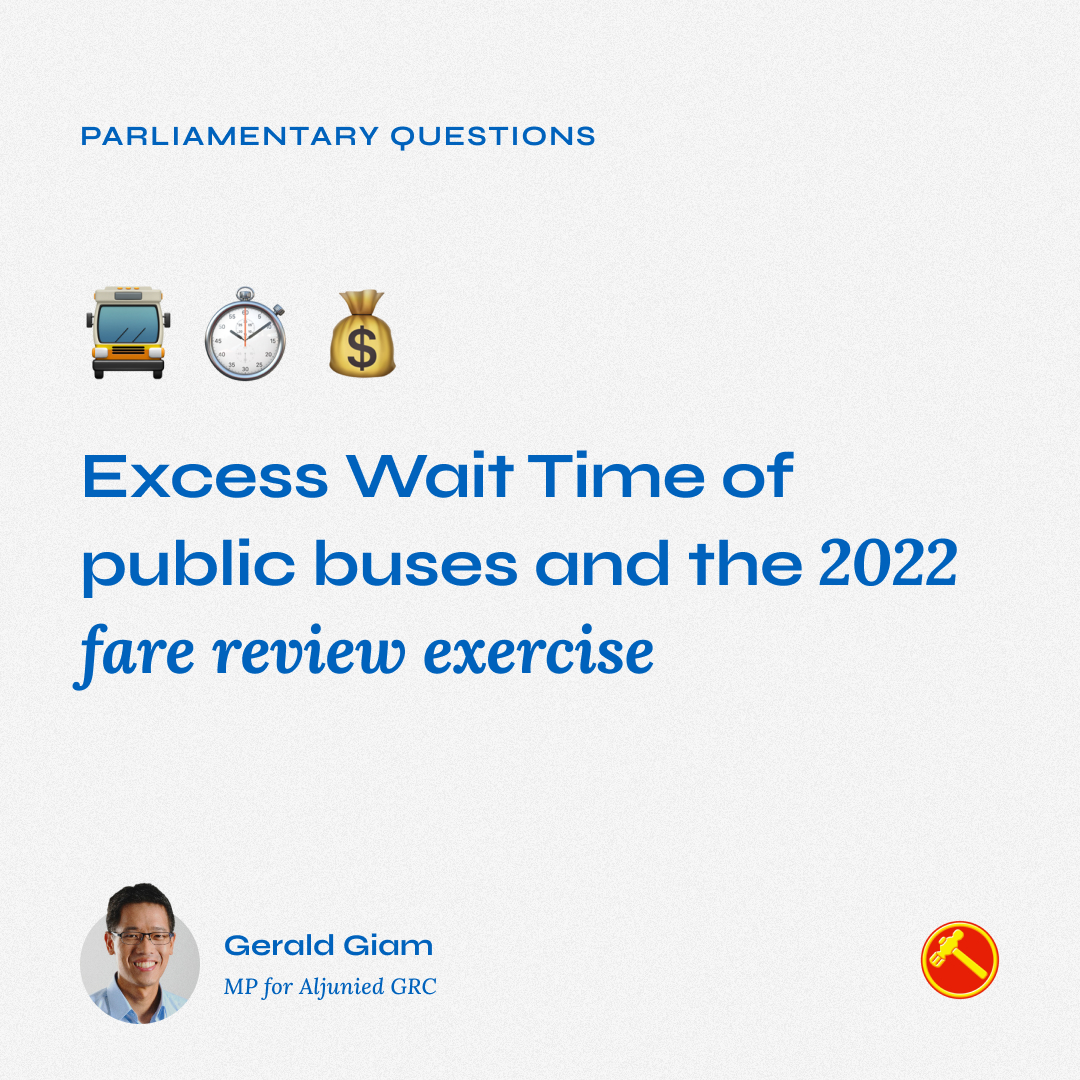I asked the Minister for Transport 3 parliamentary questions and another 4 supplementary questions regarding the new bus contracting model, during the sitting of Parliament on 7 July 2014. This is the relevant extract from the Hansard.
—————-
1. Mr R Dhinakaran asked the Minister for Transport what are the key considerations for the change in the public bus transport model and what will be the initial investment by the Government in this model.
2. Mr Christopher de Souza asked the Minister for Transport how his Ministry envisions the new bus contracting model in which operators will bid for a package of routes through competitive tendering as being able to achieve better service and affordable fares to commuters as well as the plying of buses on less lucrative but necessary routes.
3. Mr Teo Siong Seng asked the Minister for Transport whether the Government has made a provision in the budget for the new bus contracting model and, if so, whether the budget will be made transparent to the public.
4. Mr Gerald Giam Yean Song asked the Minister for Transport under the new Government contracting model for public buses (a) how does the Government plan to buy back the public bus infrastructure and operating assets currently owned by the two public transport operators (PTOs); (b) how will the value of these assets be assessed; (c) how will the Government ensure that the PTOs do not profit from the disposal of these assets; and (d) how will the Government fund these asset purchases.
5. Mr Gerald Giam Yean Song asked the Minister for Transport (a) whether the Government expects to make an operating loss over the long term under the new Government contracting model for public buses; and (b) approximately how much operating subsidies the Government expects to inject into the public bus system each year.
6. Mr Gerald Giam Yean Song asked the Minister for Transport (a) whether the Government has any plans to extend the new public bus contracting model to the MRT system; and (b) whether the Government is satisfied with the current MRT ownership and operating model.
The Minister for Transport (Mr Lui Tuck Yew): Mdm Speaker, with your permission, I would like to take Question Nos 1 to 6 together, please.
Mdm Speaker: Yes, please.
Mr Lui Tuck Yew: As announced in May, we are moving the public bus industry from the current privatised model to a Government Contracting Model.
We have been studying this move as early as the Land Transport Master Plan in 2008. Under the current model, the public bus operators rely on their fare and non-fare revenues to pay for their operations and buy operating assets, such as buses. When fare revenues are uncertain, as it has been in recent years, operators may be reluctant to expand capacity ahead of demand, or to improve service levels beyond regulatory standards on their own accord. This was why the Government had to step in with the Bus Service Enhancement Programme, or BSEP, in 2012 to quickly raise service standards and to add capacity, even as we worked towards a more sustainable bus industry model.
Under the proposed Government Contracting Model, LTA owns the buses, plans the routes and engages private bus operators through competitive tenders to run the services. This will enable us to respond more quickly and effectively to changes in ridership and commuter needs. The model also allows for more operators, potentially even overseas ones, to compete for the contracts. Bus operators will need to compete on the basis of costs and service quality. Over time, this will lead to the provision of better bus services in a cost-competitive manner, thereby benefitting commuters.
Mr Dhinakaran, Mr Gerald Giam, and Mr Teo Siong Seng asked whether the Government is setting aside a budget for the new bus contracting model, and how much the Government will subsidise bus operations. I think it is probably not in the Government’s interest to reveal any budget that we may have set aside and how much we are prepared to subsidise before the tenders are issued and the returns are seen, as this may well skew the bids against us.
The eventual amount of subsidy will crucially depend on whether fares and bus service standards are set realistically. Regardless of industry model, the cost of the overall bus system has to be paid for either by commuters in the form of fares, or taxpayers in the form of Government subsidies. There surely is no free lunch. Therefore, we have to strike the right balance. The Government is committed to ensure the affordability of public transport fares. However, regular fare adjustments are still necessary to ensure the overall financial sustainability of the public transport system.
Likewise new bus routes and higher service levels have to be assessed judiciously. Even today, we receive many requests to run bus routes that have low ridership. From the point of view of the select few who benefit, these bus routes are of course “necessary”. But if we run too many of these routes throughout the system, either higher fares, or more Government subsidies, will be required.
Mr Giam asked about how we intend to treat the current bus assets owned by the two incumbent public bus operators. We will discuss this issue as part of our negotiations with SBST and SMRT on the nine bus packages that they will continue to operate after 2016.
Finally, Mr Giam may perhaps not be aware that we have already implemented the New Rail Financing Framework (NRFF) starting with the Downtown Line last year, even before the announcement of the public bus contracting model. In fact, the Government Contracting Model for buses brings us closer to the NRFF, where the Government, instead of the operator, owns the operating assets and is responsible for major capital asset investments.
Mdm Speaker: Mr Gerald Giam.
Mr Gerald Giam Yean Song (Non-Constituency Member): Thank you, Madam. I have four supplementary questions, three of which are related to each other. First is how does the Government ensure that there is genuine contestability and competition among the operators so that they will be kept on their toes to constantly improve service quality and efficiency? How will it ensure that the new model will not see the same few players dominating the market?
Secondly, how will the Government ensure that it is easy for new players to enter the market, and also easy for non-performing operators to exit?
Thirdly, how many new players does the Government plan to allow into this market?
Fourthly, does the Government have plans to set up a corporatised, not-for-profit entity like a National Transport Corporation or Transport for London, that manages the assets in the day-to-day operations of the bus network, while leaving LTA to play the regulatory and planning role, as this could lead to greater efficiency and accountability, and minimise the risk of regulatory capture?
Mr Lui Tuck Yew: Mdm Speaker, I thank the Member for his supplementary questions. Perhaps, I will start with a reply to how we would encourage new players to enter the market, and then, I will go into the specifics of contestability and how many new players.
One important thing is to lower barriers to entry, which is why we decided that as we embarked into the Government Contracting Model that it would be best for LTA to purchase and own the buses. For each package, you may be looking at perhaps 400-500 buses. For 400 buses, you may be looking at $150 million and $200 million dollars – quite a significant capital investment if it has to be invested by a new player.
We do not want to preclude the possibility of operators that are already in the local market, running private buses quite efficiently, who may be prepared to make a bid for one of these packages, provided we lower the barriers to entry.
How do we ensure genuine contestability? Well, to have as many bidders as possible. To make the bidding as simple as it can be, so that your evaluation is as straightforward as possible.
There is another reason why we have decided to purchase and provide the buses. Because we intend to have a five plus two option – five years, with the option for an operator, if he is successful and performing well, to extend for another two years. So this is five plus two. After that, it is re-tendered.
Obviously, the lifespan of a bus extends well beyond the five or seven years. If an operator were to bring in their own buses, then the challenge is how do they cost this into their bid? Do they bring in second-hand buses, meaning the life span would run out by the time they finish; or do they bring in new buses knowing that this could disadvantage operators from certain countries, for example, the European countries because they are on the different side of the road. And so the buses that they use here may well not be so suitable if they were to use it some other place, like back in their home countries.
So, genuine contestability comes about from lowering the barriers to entry, making sure that you have got competitive bids, structuring the tender so that it is as clear and as simple as possible so that when you evaluate, you can evaluate across a common base line, so that the potential operators do not need to price in too many areas of uncertainty.
As to how many new players, we actually are open to this. The initial part is that three of the 12 packages will be put up for tenders and we will then negotiate with SBST and SMRT to run the remaining nine packages. Over the longer period, the intent is to put up all 12 packages for tender. Whether we continue to have two, three or more players will depend on the returns that come in.
On the not-for-profit entity and whether there should be a corporate player to own the buses, we do not see a necessity for that at this point in time. Basically, it is really the same model that we are trying to adopt as for rail. In rail, we provide the infrastructure, we provide the first set of rolling stock, and the operator then subsequently buys it over at the right point in time. The bus industry had been operating on quite a different model in the past because the operators used to have to pay for the depots, buses and everything. What we are trying to do here in the Government Contracting Model is to provide as much as possible the same kind of support to the bus industry as we did to the rail industry in the early years.
——–
Source: Singapore Parliament Reports (Hansard)



